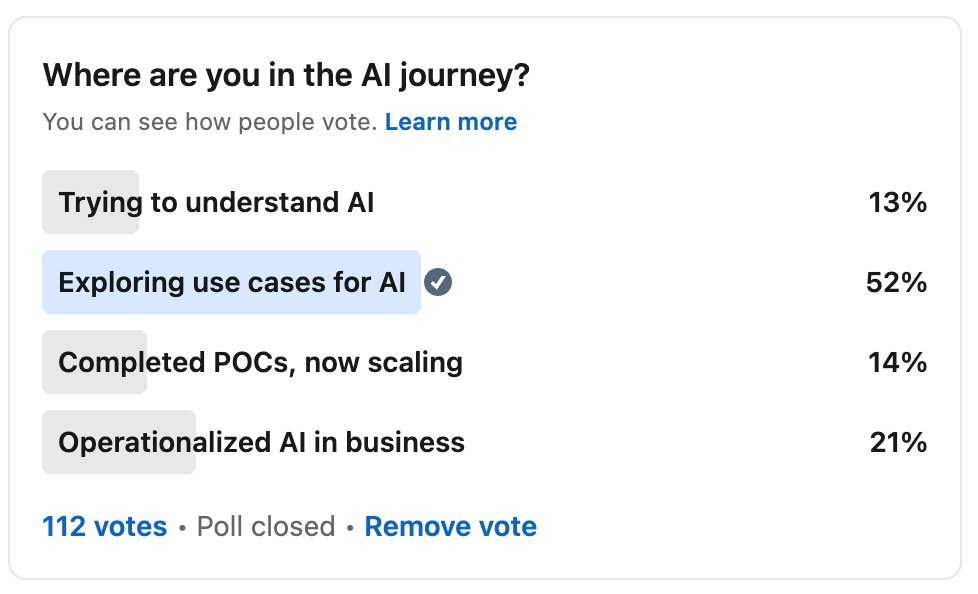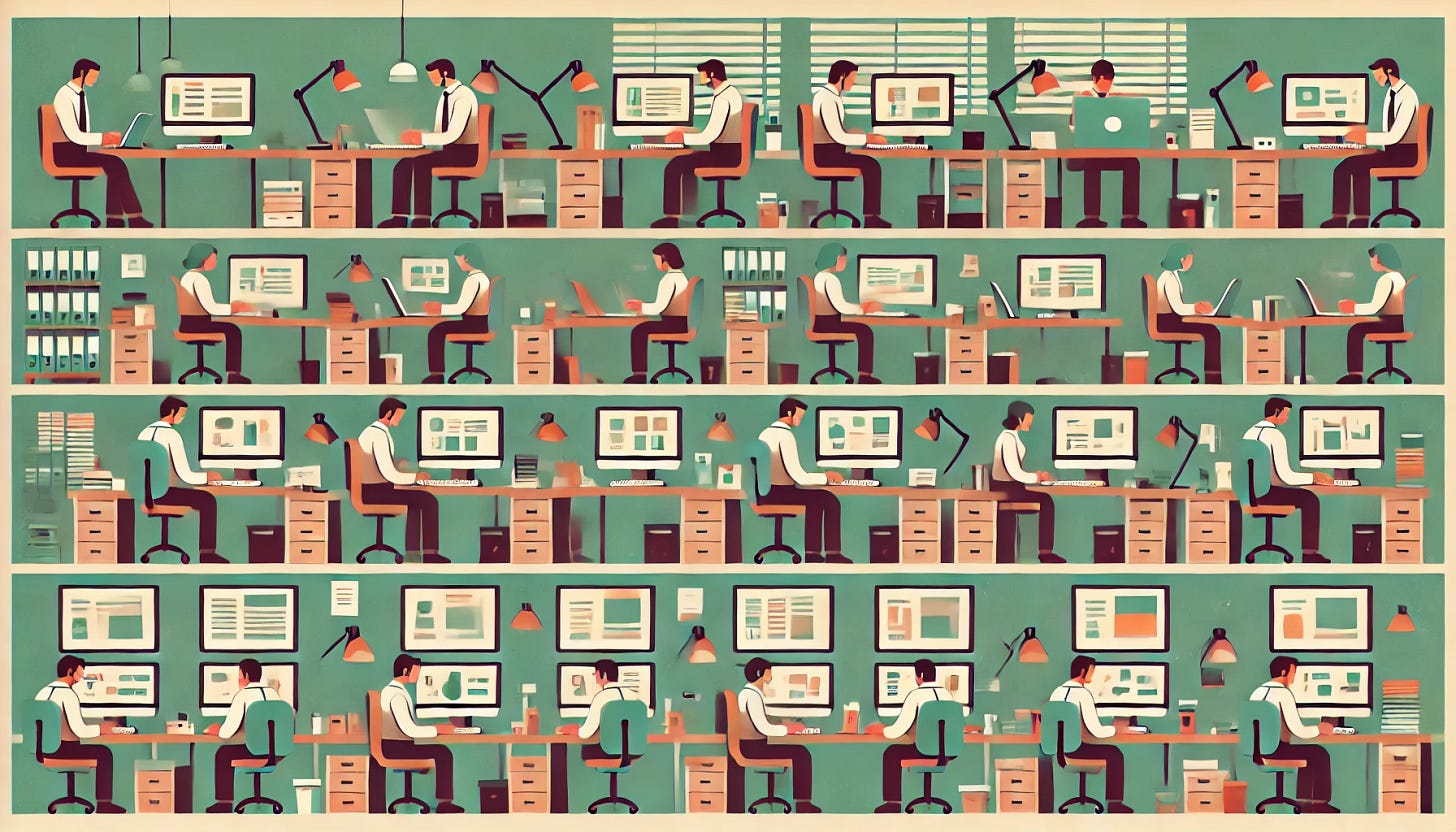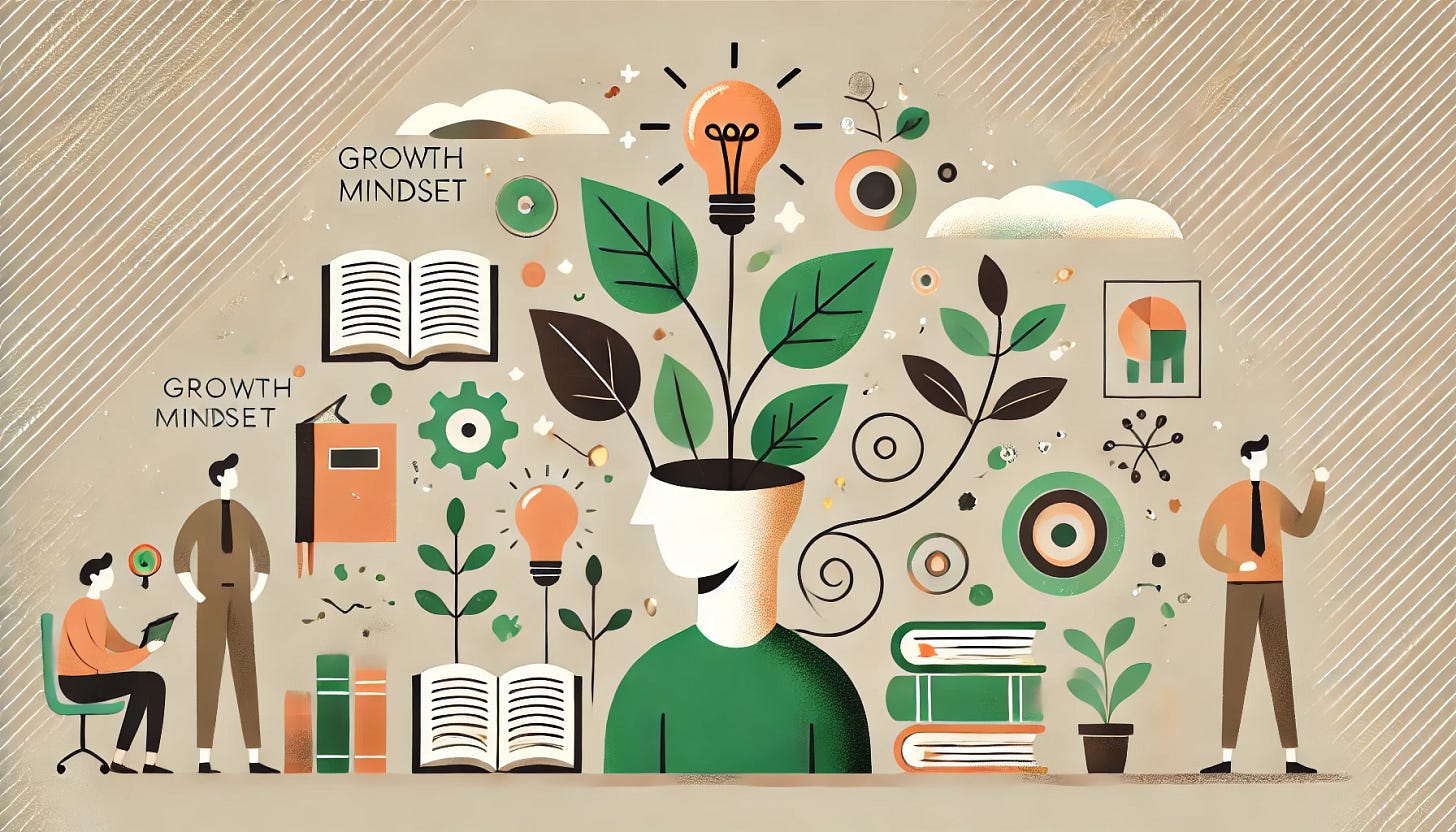Inversion Technique: Method to Future-proof your career with AI
A powerful mental model to help motivate you to up-skills and find practical ways to apply AI in your work.
I’ll admit, I am annoyed by the noise in the market about AI, it’s difficult to know where to turn for guidance or advise on where or how to get started with AI.
Everyone’s doing AI.
Everyone uses AI daily.
Everyone’s an “AI expert.”
Now there is added pressure to up-skill with AI because of the possibilities of AI “taking over jobs.”
It seems that people are still looking for guidance to get started with AI.
In fact, a couple of months ago, I asked my LinkedIn audience:
Overwhelmingly, 65% of people are still either trying to understand AI or exploring use cases for AI.
I was quite surprised by these results.
ChatGPT has been around for over a year and a half, I thought people were further along on their AI journey.
But thinking back to when I got started with AI in 2021, I was thrown into the deep end with AI and was frantically searching for lifesaver to keep myself from drowning in all there is to learn about AI.
Well …
Where there’s a will, there’s a way.
I’ve been recently reading Poor Charlie's Almanack: The Wit and Wisdom of Charles T. Munger, and was inspired to create a method to help you master AI and future-proof your career by proactively up-skilling yourself, applying it strategically and mastering how to use technology in your work.
But first … for those who aren’t familiar with Charles Munger:
Charles Munger was a renowned investor and vice chairman of Berkshire Hathaway, popularized the inversion technique as a strategic way to tackle problems.
Instead of solely focusing on how to achieve your goals, he used the inversion technique encourages to think about what you want to avoid.
So instead of asking “how do I ensure I am successful” and creating an action plan based on achieving this objective.
He asked “what do I have to do to ensure I fail?”
This flipped perspective can illuminate hidden pitfalls and guide you in creating a more robust plan.
It pushes you to think about the worst case scenario and inspire action.
In my perspective, it exposes your true fears and helps you create a plan to ensure the worst case scenario does not come to fruition.
In essence, the inversion technique involves three key steps:
Define the Problem in Reverse: Think about what you don’t want to happen.
Identify Obstacles and Errors: Determine what could go wrong.
Develop Strategies to Avoid Pitfalls: Formulate actions to prevent these negative outcomes.
Now, let’s apply this method to future-proofing your job against the rise of AI.
STEP 1. Identify Vulnerabilities
Inversion Question: What characteristics of my job make it vulnerable to AI replacement?
Begin by scrutinizing your role through the lens of vulnerability. Jobs that involve repetitive tasks, predictable patterns, and rule-based decision-making are prime candidates for automation. If your daily duties include data entry, basic analysis, or routine administrative work, you might be at risk.
Consider: repetitive tasks, predictable patterns, rule-based decision-making, and limited need for human judgment.
STEP 2. Analyze Job Components
Inversion Question: Which aspects of my role are most likely to be automated?
Break down your job into its core components. Identify tasks that are routine and repetitive—these are the ones AI can handle efficiently. For instance, if your role involves processing invoices or scheduling meetings, these tasks could be automated.
Consider: tasks like data entry, basic analysis, routine administrative duties, and standardized processes.
STEP 3. Understand AI Limitations
Inversion Question: What tasks or skills are currently beyond AI’s capabilities?
AI excels at handling structured data and predictable tasks but struggles with nuances that require human judgment, creativity, and emotional intelligence. Complex problem-solving, strategic planning, and interpersonal communication are areas where humans still outperform machines.
Consider: tasks requiring creativity, nuanced decision-making, empathy, complex problem-solving, strategic planning, and interpersonal communication.
STEP 4. Develop Inimitable Skills
Inversion Question: How can I make myself indispensable by cultivating skills AI cannot easily replicate?
To future-proof your career, focus on honing skills that are challenging for AI to replicate. Develop your emotional intelligence, leadership abilities, creative thinking, and strategic planning. Invest in continuous learning and professional development in these areas.
Consider: focus on developing and enhancing skills such as emotional intelligence, leadership, creative thinking, complex problem-solving, and advanced strategic planning.
Action Steps:
Invest in continuous learning and professional development in these areas.
Seek mentorship and networking opportunities to enhance your leadership and interpersonal skills.
Engage in roles and projects that require innovative thinking and strategic vision.
STEP 5. Enhance Human-AI Collaboration
Inversion Question: How can I resist or fail to integrate AI into my work effectively?
Avoid the pitfall of ignoring AI advancements. Instead, embrace AI as a tool to augment your productivity and decision-making capabilities. Learn about AI tools relevant to your industry and explore how they can enhance your work.
Consider: by ignoring AI advancements or not understanding how to leverage AI to complement your work.
Strategy: Embrace AI as a tool to enhance your productivity and decision-making capabilities.
Action Steps:
Learn about AI tools relevant to your industry and how they can improve your work.
Participate in AI training programs and workshops.
Experiment with AI tools to improve efficiency and innovation in your tasks.
STEP 6. Stay Informed and Adaptable
Inversion Question: What if I remain unaware of industry trends and technological advancements?
Staying current with industry trends and technological advancements is crucial. By being well-informed, you can adapt to changes and leverage new tools to your advantage.
Consider: You might become outdated and unable to adapt to new developments.
Strategy: Stay informed about the latest trends in AI and your industry, and be ready to adapt.
Action Steps:
Subscribe to (my newsletter - sorry, shameless plug), industry publications, attend conferences, and join professional networks.
Regularly update your skills and knowledge through courses, certifications, and training programs.
STEP 7. Create a Unique Value Proposition
Inversion Question: What can I do to ensure my contributions are easily replaceable by AI?
Your goal is to develop a unique value proposition that highlights your distinctive skills and contributions. Focus on areas where you can create innovative solutions and add value in ways that AI cannot.
Consider: performing tasks that are easily replicable and lack unique value.
Strategy: Develop a unique value proposition that highlights your distinctive skills and contributions.
Action Steps:
Identify your strengths and how they align with your organization’s strategic goals.
Focus on creating innovative solutions and adding value in ways that AI cannot.
Build a personal brand that emphasizes your unique expertise and thought leadership.
8. Foster a Growth Mindset
Inversion Question: What if I become complacent and resist change?
Complacency can be a career killer, especially in a fast-evolving tech landscape. Cultivate a growth mindset that embraces change and continuous improvement.
Consider: You might fall behind as the industry evolves.
Strategy: Cultivate a growth mindset that embraces change and continuous improvement.
Action Steps:
Regularly set personal and professional development goals.
Seek feedback and act on it to improve your skills and performance.
Embrace challenges and view them as opportunities for growth.
By applying Charles Munger’s inversion technique, you can proactively identify and mitigate the risks of AI replacement.
I hope that this approach not only helps you understand what to avoid but also guides you in developing a strategy to remain valuable and relevant in the job market.








I love thinking in inversions.
It is not something I have been doing recently.
Thank you for the reminder.